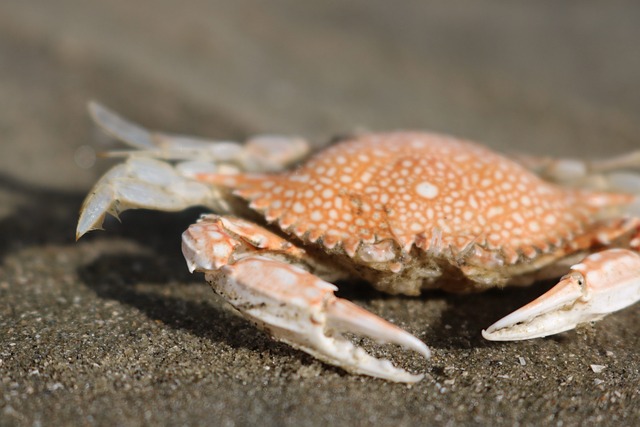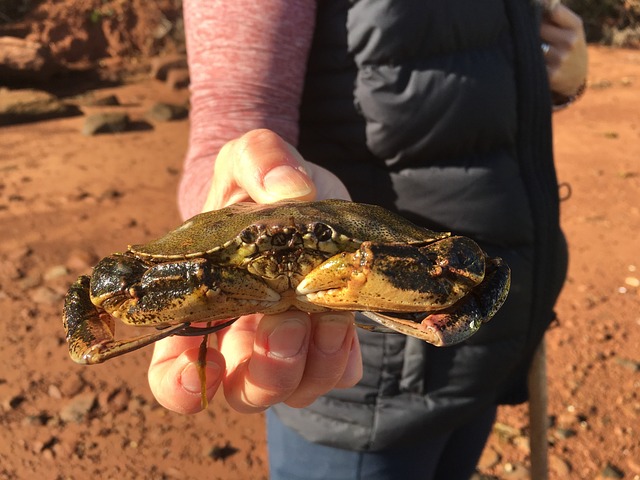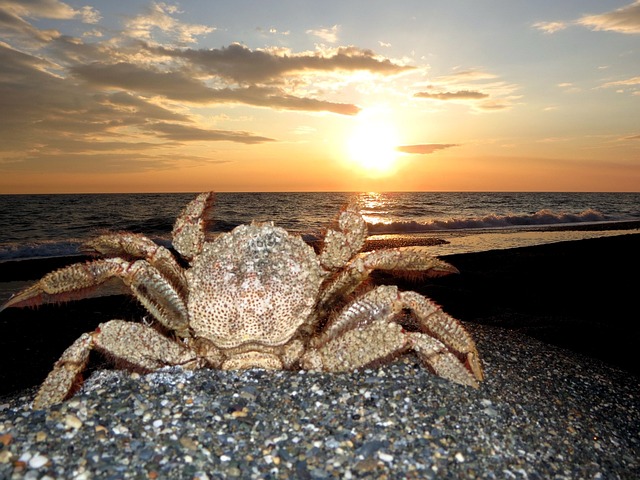Yes, shore crabs (Carcinus maenas) can be eaten in the UK. Shore crabs are commonly found along the coastlines of the UK and many other regions. They are edible and are occasionally consumed by people who enjoy foraging for seafood.
What are the key characteristics of shore crabs?
Hidden along coastal landscapes, shore crabs reveal a world of captivating adaptations and behaviors that define their pivotal role in intertidal ecosystems.
Physical appearance and distinguishing features:
Shore crabs (Carcinus maenas) are small to medium-sized crustaceans with distinctive characteristics that aid in their identification. Additionally, they have a hard exoskeleton that protects their body. Some key physical features include:
- Carapace: The shell covering the crab’s body is typically green or brown with irregular patterns. It can grow up to 8 cm in width.
- Pincers: Shore crabs have unequally sized pincers, with one larger and one smaller. The larger pincer is used for crushing food while the smaller one is used for manipulation.
- Legs: They have eight walking legs, often with small spines and hairs for mobility and gripping surfaces.
- Coloration: The coloration can vary widely, providing camouflage in different coastal environments.
Common habitats and distribution in the UK:

Shore crabs are incredibly adaptable and can be found along the coastlines of the United Kingdom.
Additionally, they thrive in a variety of habitats, including rocky shores, sandy beaches, and intertidal zones. They are known for their ability to tolerate a range of salinities and temperatures.
Furthermore, their distribution is influenced by factors such as food availability and substrate for shelter. The crabs are often found hiding under rocks and seaweed during low tide and can scavenge for food in tide pools and shallow waters.
Are shore crabs edible and safe to eat?
Exploring both the gastronomic curiosity and safety considerations :
Historical and cultural context of crab consumption:
Crab consumption has historical roots in coastal communities across the UK. In some regions, crabs have been part of local diets for generations, utilized in both traditional and modern culinary practices. Moreover, they were once considered a cheap and readily available source of protein.
Nutritional value and potential health benefits:
Shore crabs offer a good nutritional profile. They are low in fat and calories but rich in protein.
In addition, they also provide essential vitamins and minerals such as B vitamins, copper, zinc, and selenium. Consuming crab meat can contribute to a balanced diet and support muscle growth and repair.
Consideration of local fishing regulations and conservation efforts:
When considering the edibility of shore crabs, it’s crucial to be aware of local fishing regulations and conservation efforts.
In the UK, there are regulations in place to manage crab populations sustainably and prevent overharvesting. Furthermore, some regions may have restrictions on size, quantity, and harvesting methods.
Hence, engaging in responsible fishing practices helps ensure the longevity of crab populations and the overall health of marine ecosystems.
What is the best way to prepare shore crabs for eating?
Unlocking the culinary potential of shore crabs hinges on mastering the art of their preparation
Cleaning and handling procedures:
Before cooking shore crabs, it’s important to clean them thoroughly. This involves removing the carapace, gills, and digestive tract. Moreover, proper cleaning helps enhance the flavor and texture of the meat.
Cooking methods and culinary uses:
Shore crabs can be prepared in various ways, including boiling, steaming, grilling, and incorporating them into soups and stews.
In addition, their meat has a delicate and slightly sweet flavor. Crab meat is often used in salads, sandwiches, and pasta dishes. The claws are particularly prized for their meat content.
What are the risks and precautions when dealing with shore crabs?
Amidst the allure of harvesting shore crabs, a prudent approach is essential to navigate the potential risks.And take necessary precautions for both the collectors and the creatures.
Allergies and sensitivities:
Some individuals may be allergic to shellfish, including crabs. Common symptoms of shellfish allergy include hives, swelling, itching, and in severe cases, anaphylaxis. Moreover, anyone with a known shellfish allergy should avoid consuming shore crabs.
Parasites and contaminants:
Crabs, like other seafood, can contain parasites and contaminants. Freezing the crab meat before consumption can help kill parasites.In addition, it’s also essential to source crabs from reputable suppliers who adhere to food safety standards.
Advisories for pregnant women and vulnerable populations:
Pregnant women, young children, the elderly, and individuals with weakened immune systems should exercise caution when consuming seafood.
Moreover, they are more susceptible to the effects of contaminants and should follow dietary guidelines provided by health authorities.
What is the public perception of shore crab consumption?
Public perception of shore crab consumption dances between curiosity and caution, shaped by a blend of cultural norms, ecological awareness, and culinary intrigue.
Traditional and modern culinary practices:
Shore crabs have been traditionally used in various dishes, such as crab cakes and crab bisques. In addition, modern culinary trends might involve innovative crab preparations in upscale restaurants, showcasing the versatility of crab meat.
Popularity of crab dishes in the UK:
Crab dishes are popular in coastal regions of the UK, where fresh seafood is readily available. Moreover, crab festivals and seafood-focused events often highlight the cultural significance of crabs in local cuisine.
- Coastal Cuisine: Coastal regions of the UK, such as Cornwall and Scotland, have a strong connection to crab dishes due to their abundant seafood resources.
- Tourism and Festivals: The popularity of crab dishes is often amplified during seafood festivals and events, drawing both locals and tourists to savor the region’s seafood offerings.
- National and International Markets: Crab dishes, especially crab meat, are exported to national and international markets, showcasing the demand for these culinary delights.
What do experts and scientific studies say about shore crab?

Insights garnered from experts and scientific studies unveil a tapestry of knowledge about shore crabs, shedding light on their behaviors, ecological roles, and the intricate web of interactions they engage in.
Insights from marine biologists and food scientists:
- Sustainability: Marine biologists emphasize the importance of sustainable fishing practices to maintain healthy crab populations. In addition, they might offer insights into population dynamics and the potential impact of overfishing.
- Ecosystem Role: Experts might discuss the ecological role of crabs in coastal ecosystems, shedding light on their interactions with other species and habitats.
Findings from research on crab safety and consumption:
- Food Safety Measures: Food scientists study the best practices for cleaning, handling, and cooking crabs to ensure their safety for consumption. Furthermore, they might provide guidelines on proper cooking temperatures and handling to prevent foodborne illnesses.
- Contaminant Levels: Research may analyze the levels of contaminants, such as heavy metals and microplastics, in crab meat. Additionally, these findings help inform consumers and regulatory agencies about potential health risks.
What are some anecdotes related to shore crab consumption?
From coastal kitchens to seaside tales, anecdotes about shore crab consumption paint a mosaic of experiences.
- Cultural Significance: In some coastal communities, crab consumption is intertwined with local traditions and cultural events. In addition, this might include rituals, festivals, or ceremonies centered around crab dishes.
- Economic Impact: Local economies in fishing villages often rely on crab harvesting and consumption.Moreover, personal anecdotes from those involved in the industry can reveal the economic importance of crab-related activities.
FAQ’s :
Are UK shore crabs edible?
Yes, UK shore crabs are edible and have been consumed as part of culinary traditions.
What crabs are edible in the UK?
Various crab species are edible in the UK, including brown crab (Cancer pagurus) and velvet swimming crab (Necora puber).
Is it illegal to take crabs from the UK?
It’s not illegal to take crabs from the UK, but there are regulations in place to ensure sustainable harvesting and protect marine ecosystems.
Can you take crabs home from the beach in the UK?
Yes, you can take crabs from the beach in the UK for personal consumption, but it’s important to adhere to local fishing regulations and size limits.
Are there any poisonous crabs in the UK?
While there are no known highly poisonous crabs in the UK, some crabs might carry toxins or contaminants, emphasizing the need for proper cleaning and preparation.
Does England have freshwater crabs?
Yes, England is home to freshwater crabs, with the native white-clawed crayfish being one example.
Do British eat crab?
Yes, crab is enjoyed as part of British cuisine, particularly in coastal regions where seafood is abundant.
What is the best crab to eat in the UK?
The brown crab (Cancer pagurus) is often considered one of the best crabs to eat in the UK due to its meaty claws and delicate flavor.
What is the most common crab in the UK?
The shore crab (Carcinus maenas) is one of the most common crab species found along the UK’s coastlines.
Conclusion :
In conclusion, exploring the edibility of shore crabs in the UK reveals a multifaceted landscape that intertwines culinary traditions, scientific insights, personal experiences, and environmental considerations.
Moreover, shore crabs, with their distinctive physical characteristics and widespread distribution along the UK’s coastlines. In addition, it has been consumed historically as a source of sustenance and cultural significance.
Moreover, their nutritional value and potential health benefits have contributed to their popularity in traditional and modern culinary practices.
However, consuming shore crabs requires careful attention to various factors. Proper cleaning and handling procedures are essential to ensure the safety and palatability of the meat.
In addition, different cooking methods provide diverse culinary possibilities, from traditional recipes to innovative creations in upscale dining establishments.
Finally, the popularity of crab dishes in coastal regions, the preservation of local stories and traditions, and the expert insights from marine biologists and food scientists collectively highlight the importance of responsible crab consumption.

